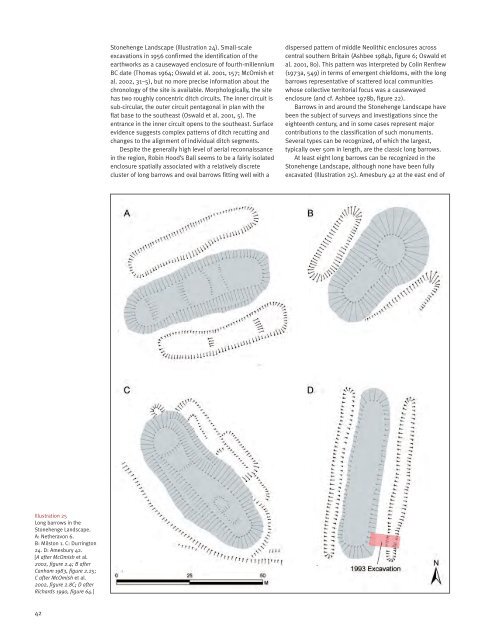stonehenge - English Heritage
stonehenge - English Heritage
stonehenge - English Heritage
Create successful ePaper yourself
Turn your PDF publications into a flip-book with our unique Google optimized e-Paper software.
047-120 section 2.qxd 6/21/05 4:18 PM Page 42<br />
Stonehenge Landscape (Illustration 24). Small-scale<br />
excavations in 1956 confirmed the identification of the<br />
earthworks as a causewayed enclosure of fourth-millennium<br />
BC date (Thomas 1964; Oswald et al. 2001, 157; McOmish et<br />
al. 2002, 31–5), but no more precise information about the<br />
chronology of the site is available. Morphologically, the site<br />
has two roughly concentric ditch circuits. The inner circuit is<br />
sub-circular, the outer circuit pentagonal in plan with the<br />
flat base to the southeast (Oswald et al. 2001, 5). The<br />
entrance in the inner circuit opens to the southeast. Surface<br />
evidence suggests complex patterns of ditch recutting and<br />
changes to the alignment of individual ditch segments.<br />
Despite the generally high level of aerial reconnaissance<br />
in the region, Robin Hood’s Ball seems to be a fairly isolated<br />
enclosure spatially associated with a relatively discrete<br />
cluster of long barrows and oval barrows fitting well with a<br />
dispersed pattern of middle Neolithic enclosures across<br />
central southern Britain (Ashbee 1984b, figure 6; Oswald et<br />
al. 2001, 80). This pattern was interpreted by Colin Renfrew<br />
(1973a, 549) in terms of emergent chiefdoms, with the long<br />
barrows representative of scattered local communities<br />
whose collective territorial focus was a causewayed<br />
enclosure (and cf. Ashbee 1978b, figure 22).<br />
Barrows in and around the Stonehenge Landscape have<br />
been the subject of surveys and investigations since the<br />
eighteenth century, and in some cases represent major<br />
contributions to the classification of such monuments.<br />
Several types can be recognized, of which the largest,<br />
typically over 50m in length, are the classic long barrows.<br />
At least eight long barrows can be recognized in the<br />
Stonehenge Landscape, although none have been fully<br />
excavated (Illustration 25). Amesbury 42 at the east end of<br />
Illustration 25<br />
Long barrows in the<br />
Stonehenge Landscape.<br />
A: Netheravon 6.<br />
B: Milston 1. C: Durrington<br />
24. D: Amesbury 42.<br />
[A after McOmish et al.<br />
2002, figure 2.4; B after<br />
Canham 1983, figure 2.25;<br />
C after McOmish et al.<br />
2002, figure 2.8C; D after<br />
Richards 1990, figure 64.]<br />
42

















